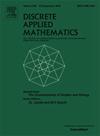在k -lca框架内对dag进行表征和转化
IF 1
3区 数学
Q3 MATHEMATICS, APPLIED
引用次数: 0
摘要
我们探索了有向无环图(dag)中聚类和最小共同祖先(lca)之间的联系,重点研究了所谓的与k -lca相关的dag和具有k -lca性质的dag之间的相互作用。这里,k表示一组整数。在与k - LCA相关的DAG中,每个顶点是大小为|A|∈k的叶子子集A的唯一LCA,而在具有k - LCA性质的DAG中,对于满足|A|∈k的叶子子集A存在唯一LCA。我们详细说明了这两个性质之间的区别,并建立了它们与前- k -任和k -任集合系统的密切关系。这反过来又推广了(预)二进位和k元集合系统的结果。此外,我们建立在最近建立的结果的基础上,该结果使用一个简单的算子,可以将任意dag转换为与k -lca相关的dag。这个过程减少了不必要的复杂性,同时保留了原始DAG的关键结构特性。集合ℭG由DAG中的所有簇组成,其中簇对应于顶点的后代叶。虽然在某些情况下ℭH=ℭG,当将G转换为与k -lca相关的DAG H时,经常会发生ℭG中的某些簇不作为H中的簇出现的情况。为了详细理解这一现象,我们描述了ℭG中保留在H中的DAG簇的子集与k -lca属性。进一步,我们证明了将G转换为H=G = W所需的顶点集W是对这样的dag唯一确定的。反过来,这允许我们证明变换后的DAG H的“无快捷方式”版本总是树或瘿树,当ℭG表示树或瘿树的聚类系统并且G具有k -lca性质时。在后一种情况下ℭH=ℭG总是成立的。本文章由计算机程序翻译,如有差异,请以英文原文为准。
Characterizing and transforming DAGs within the ℐ-lca framework
We explore the connections between clusters and least common ancestors (LCAs) in directed acyclic graphs (DAGs), focusing on the interplay between so-called -lca-relevant DAGs and DAGs with the -lca-property. Here, denotes a set of integers. In -lca-relevant DAGs, each vertex is the unique LCA for some subset of leaves of size , whereas in a DAG with the -lca-property there exists a unique LCA for every subset of leaves satisfying . We elaborate on the difference between these two properties and establish their close relationship to pre--ary and -ary set systems. This, in turn, generalizes results established for (pre-) binary and -ary set systems. Moreover, we build upon recently established results that use a simple operator , enabling the transformation of arbitrary DAGs into -lca-relevant DAGs. This process reduces unnecessary complexity while preserving key structural properties of the original DAG. The set consists of all clusters in a DAG , where clusters correspond to the descendant leaves of vertices. While in some cases when transforming into an -lca-relevant DAG , it often happens that certain clusters in do not appear as clusters in . To understand this phenomenon in detail, we characterize the subset of clusters in that remain in for DAGs with the -lca-property. Furthermore, we show that the set of vertices required to transform into is uniquely determined for such DAGs. This, in turn, allows us to show that the “shortcut-free” version of the transformed DAG is always a tree or a galled-tree whenever represents the clustering system of a tree or galled-tree and has the -lca-property. In the latter case always holds.
求助全文
通过发布文献求助,成功后即可免费获取论文全文。
去求助
来源期刊

Discrete Applied Mathematics
数学-应用数学
CiteScore
2.30
自引率
9.10%
发文量
422
审稿时长
4.5 months
期刊介绍:
The aim of Discrete Applied Mathematics is to bring together research papers in different areas of algorithmic and applicable discrete mathematics as well as applications of combinatorial mathematics to informatics and various areas of science and technology. Contributions presented to the journal can be research papers, short notes, surveys, and possibly research problems. The "Communications" section will be devoted to the fastest possible publication of recent research results that are checked and recommended for publication by a member of the Editorial Board. The journal will also publish a limited number of book announcements as well as proceedings of conferences. These proceedings will be fully refereed and adhere to the normal standards of the journal.
Potential authors are advised to view the journal and the open calls-for-papers of special issues before submitting their manuscripts. Only high-quality, original work that is within the scope of the journal or the targeted special issue will be considered.
 求助内容:
求助内容: 应助结果提醒方式:
应助结果提醒方式:


